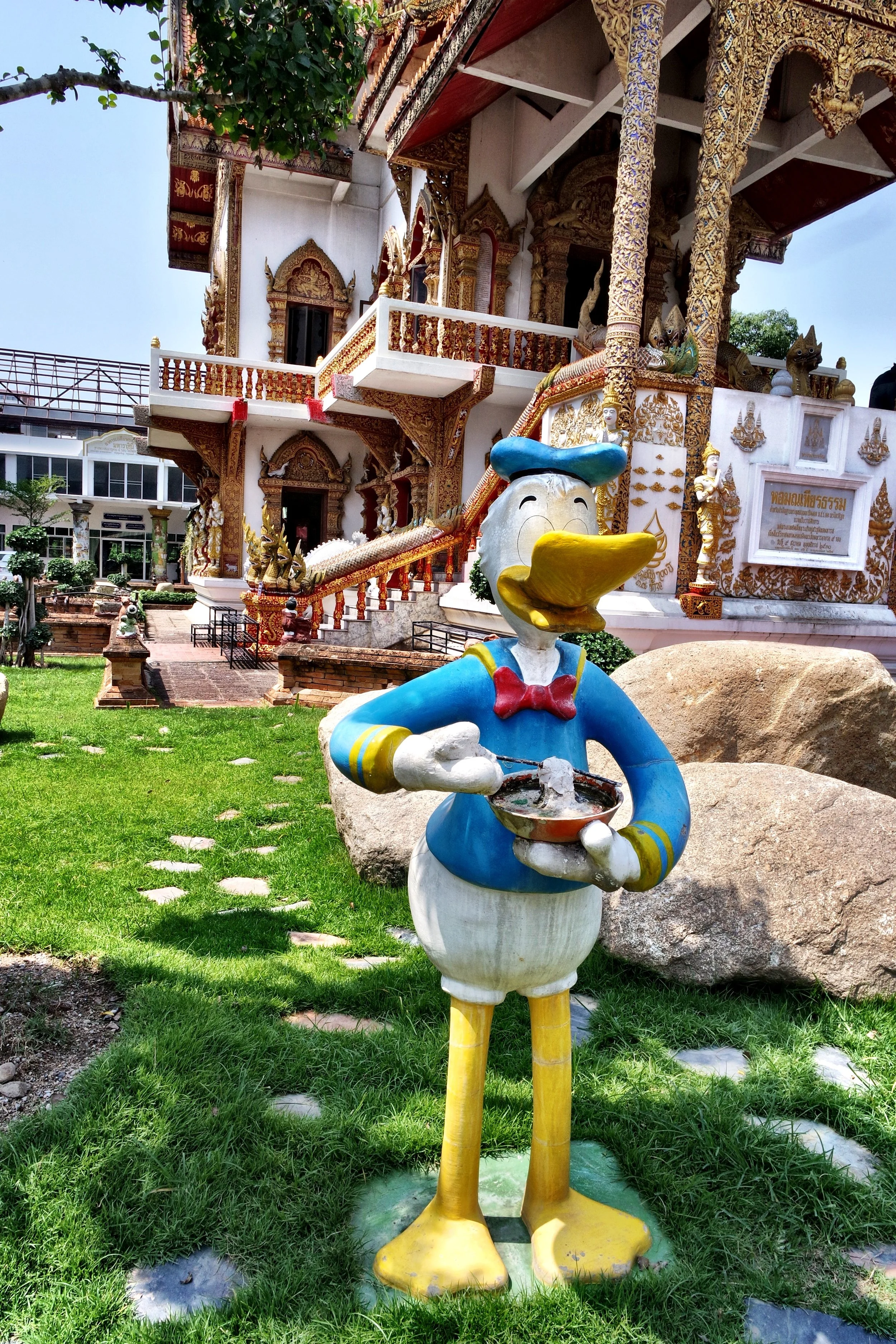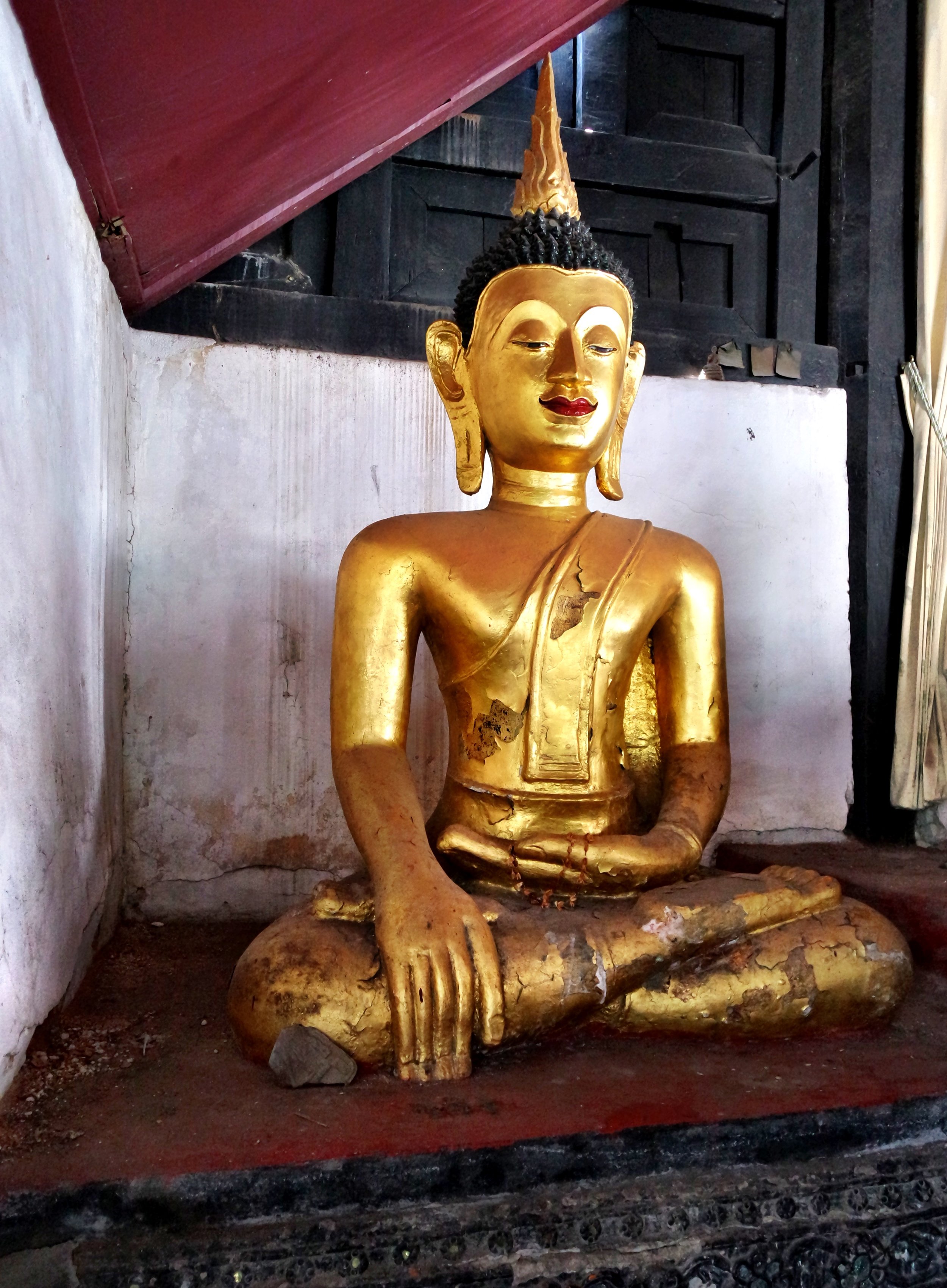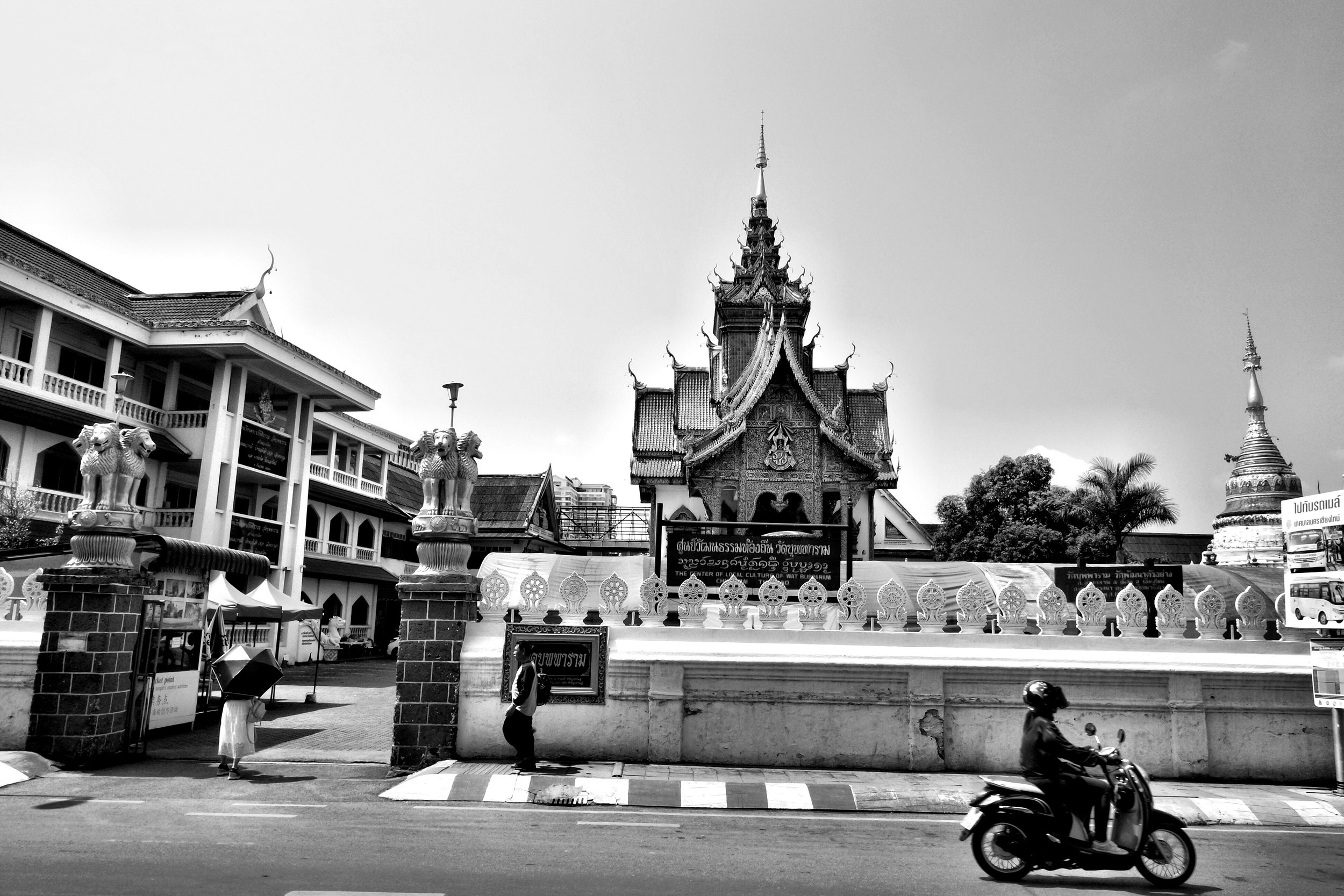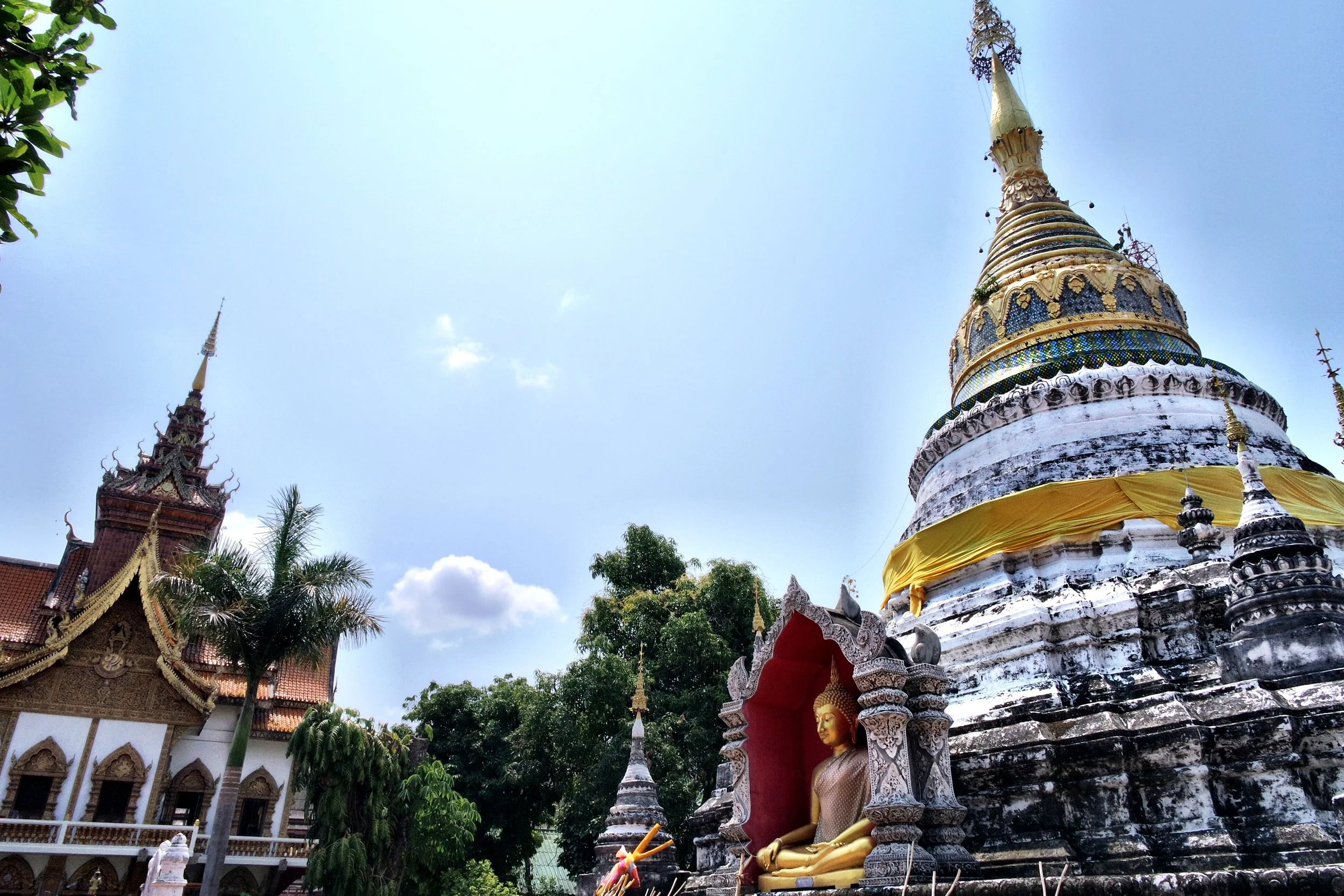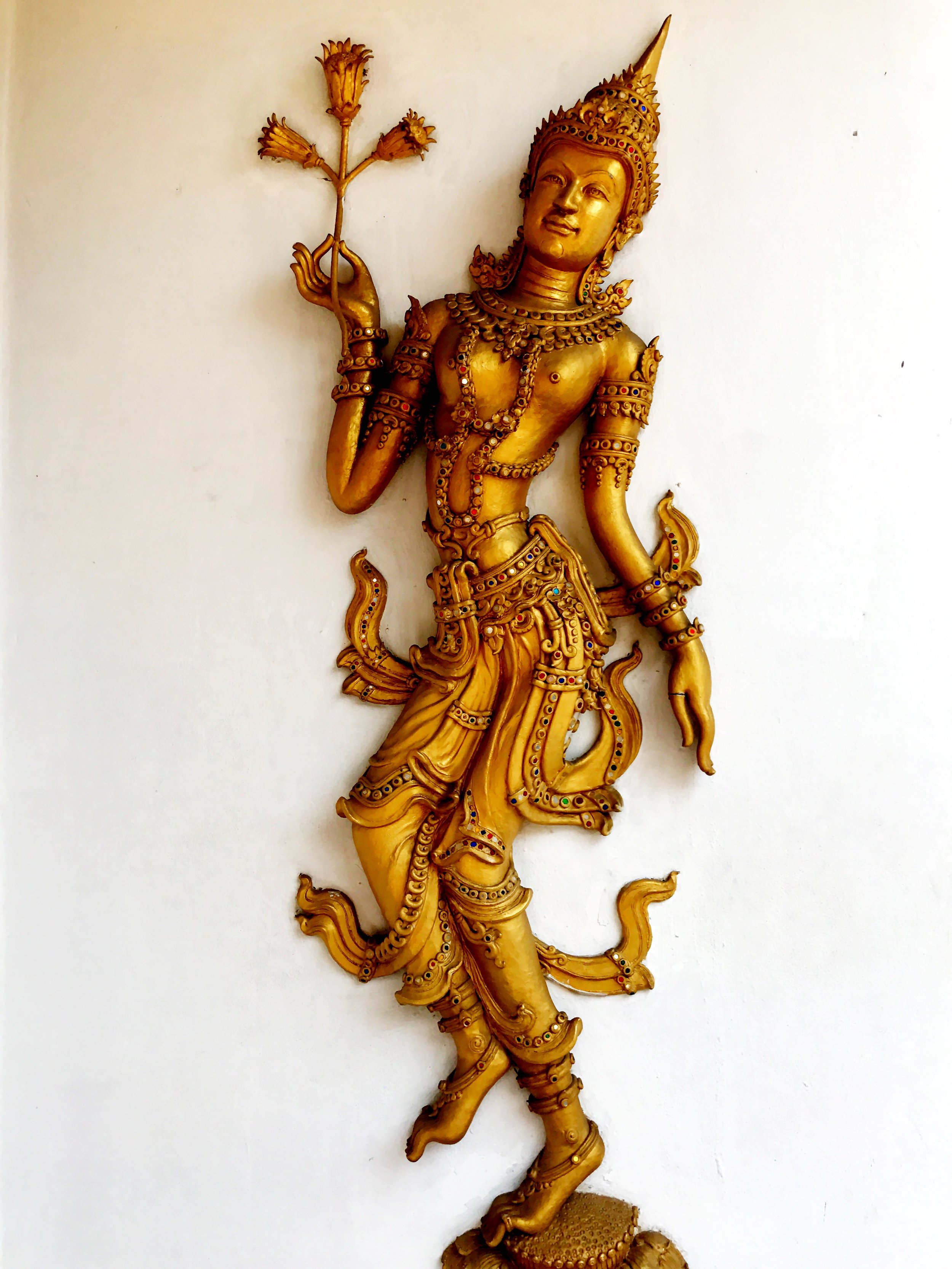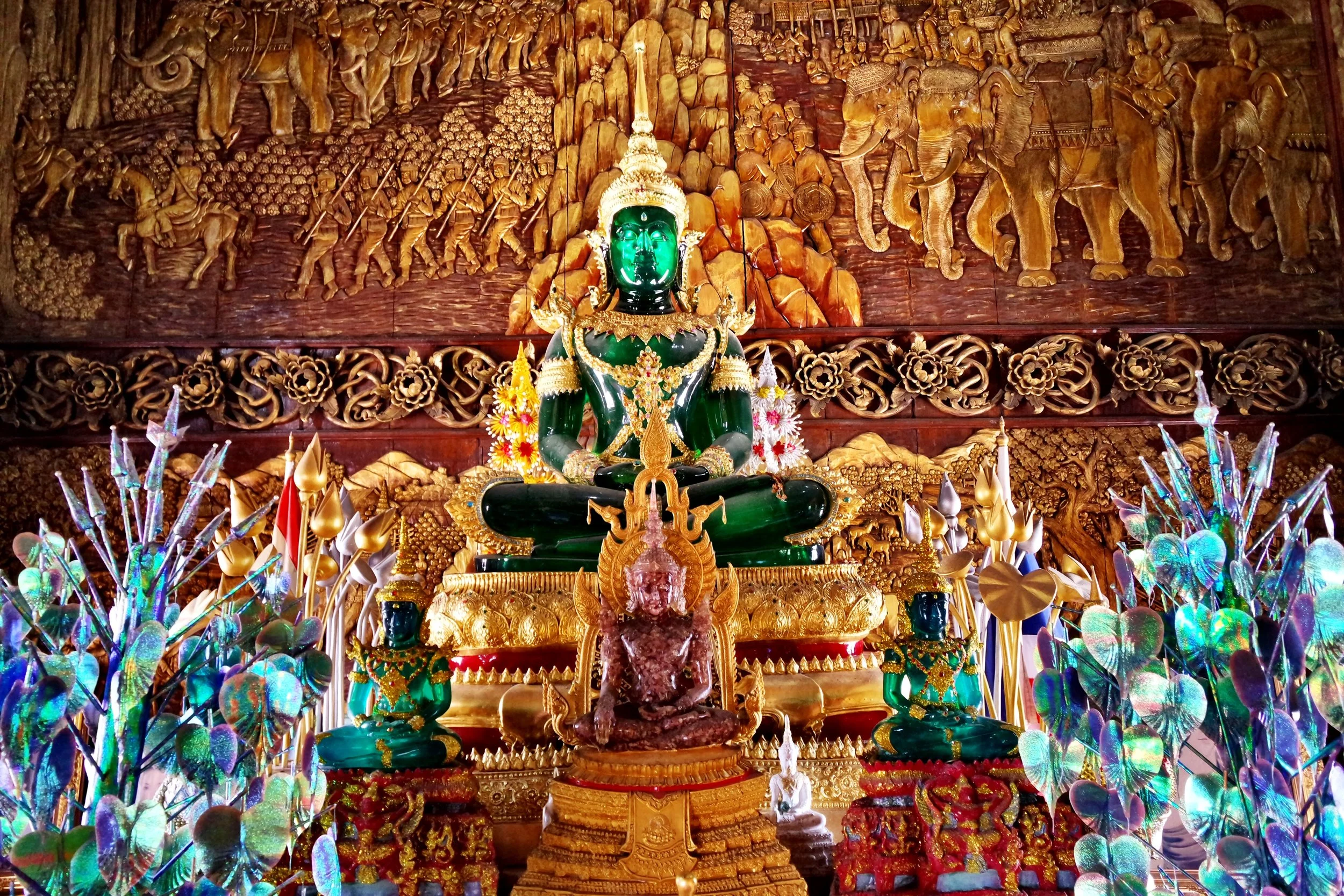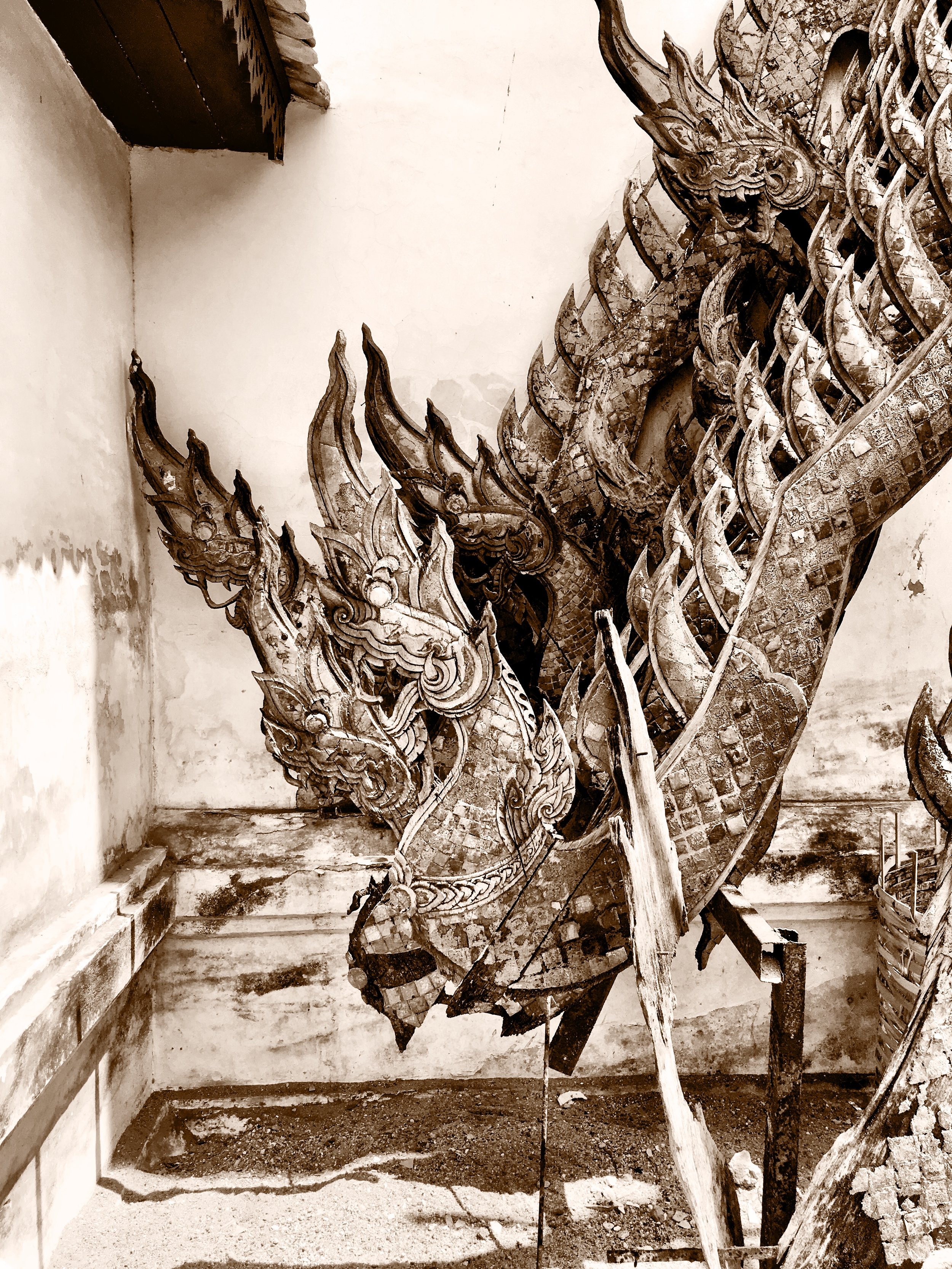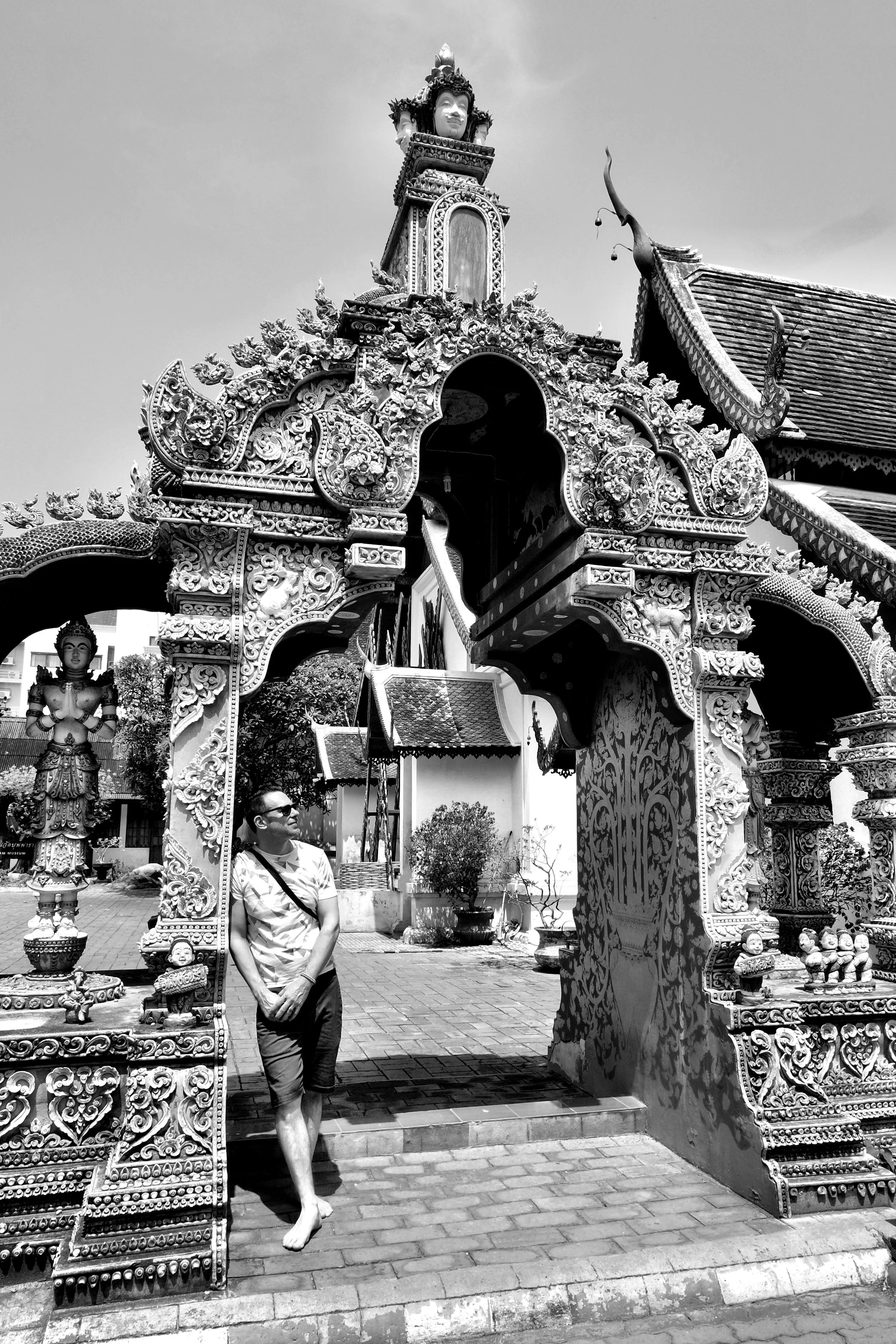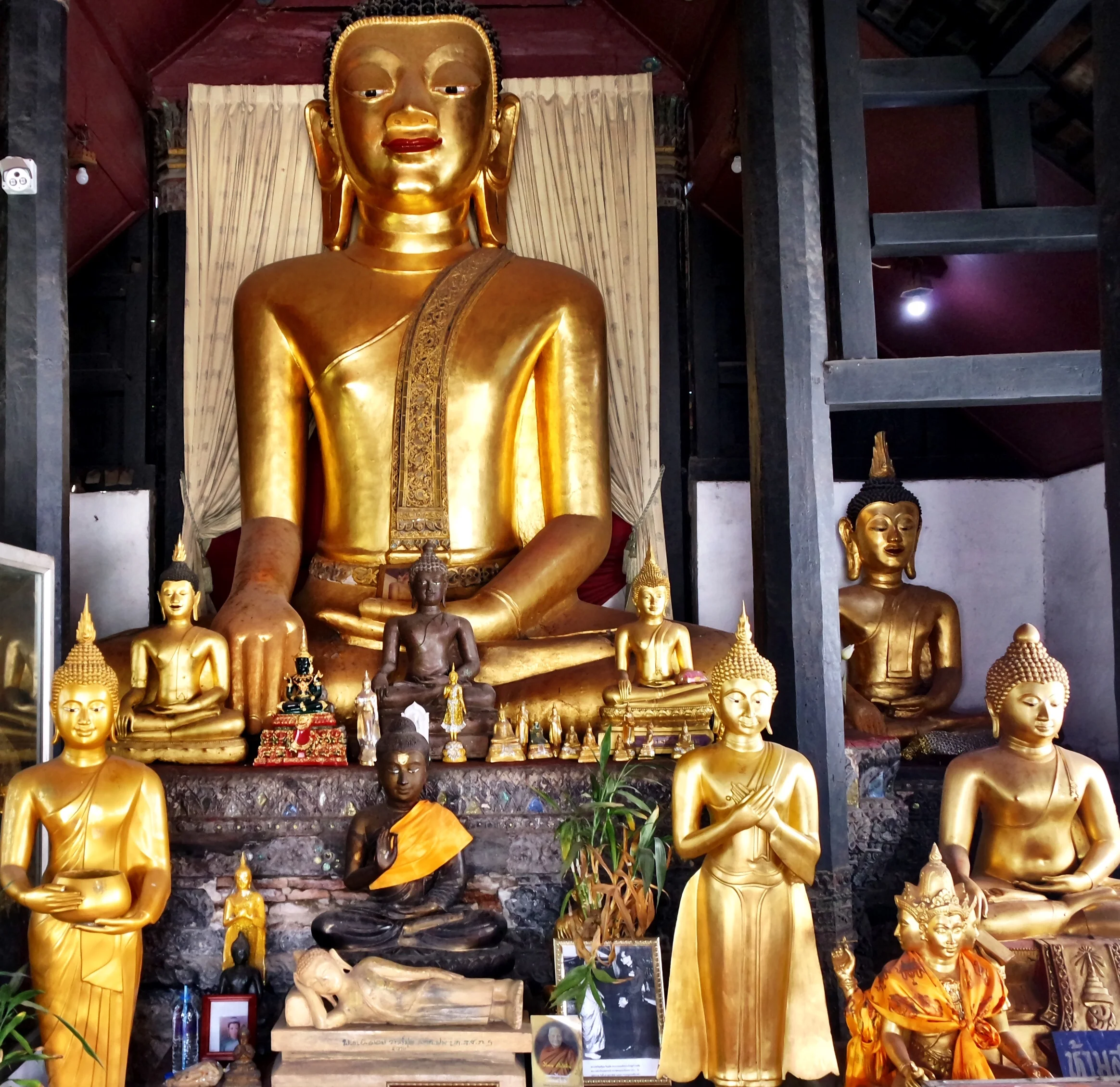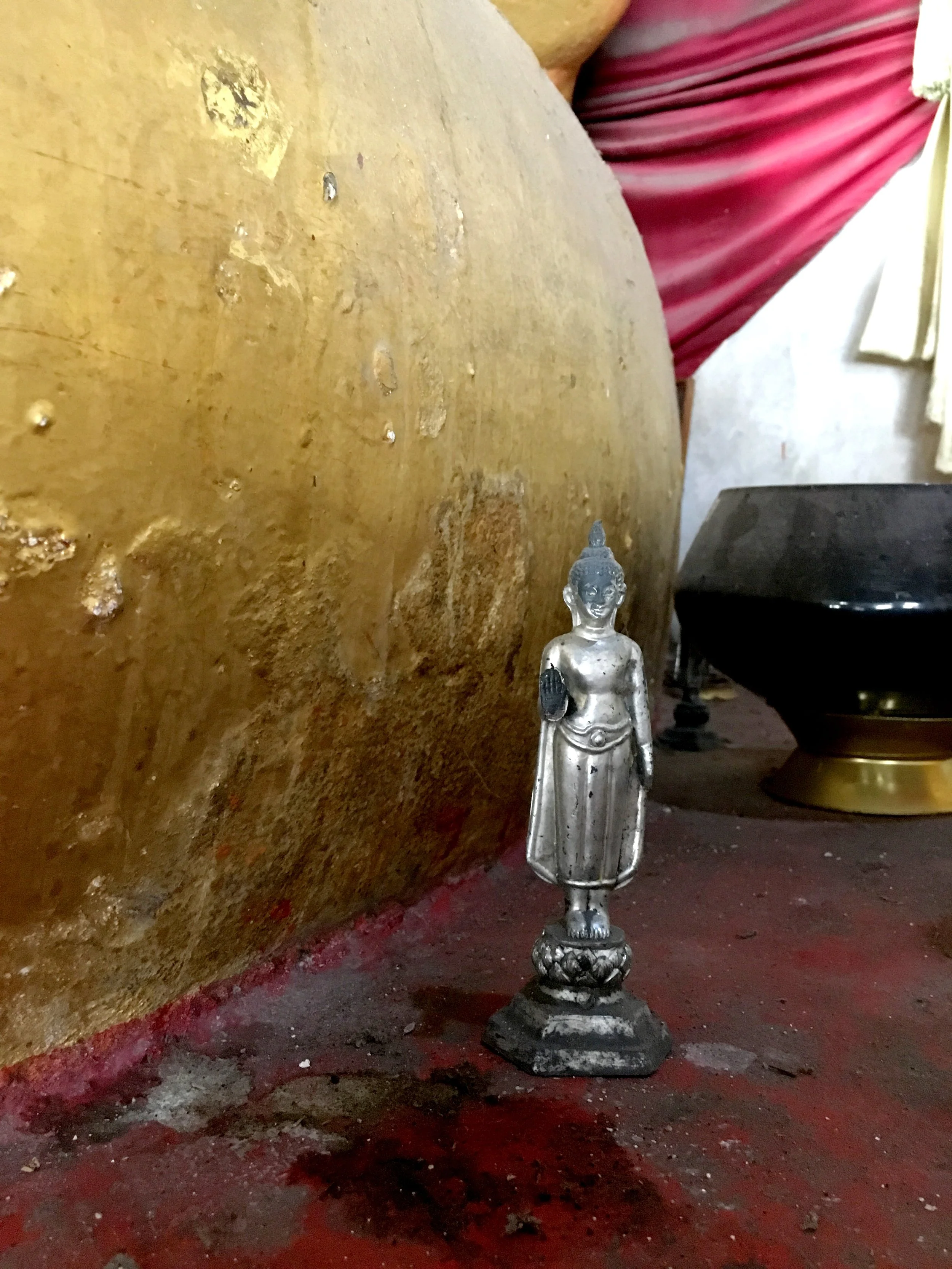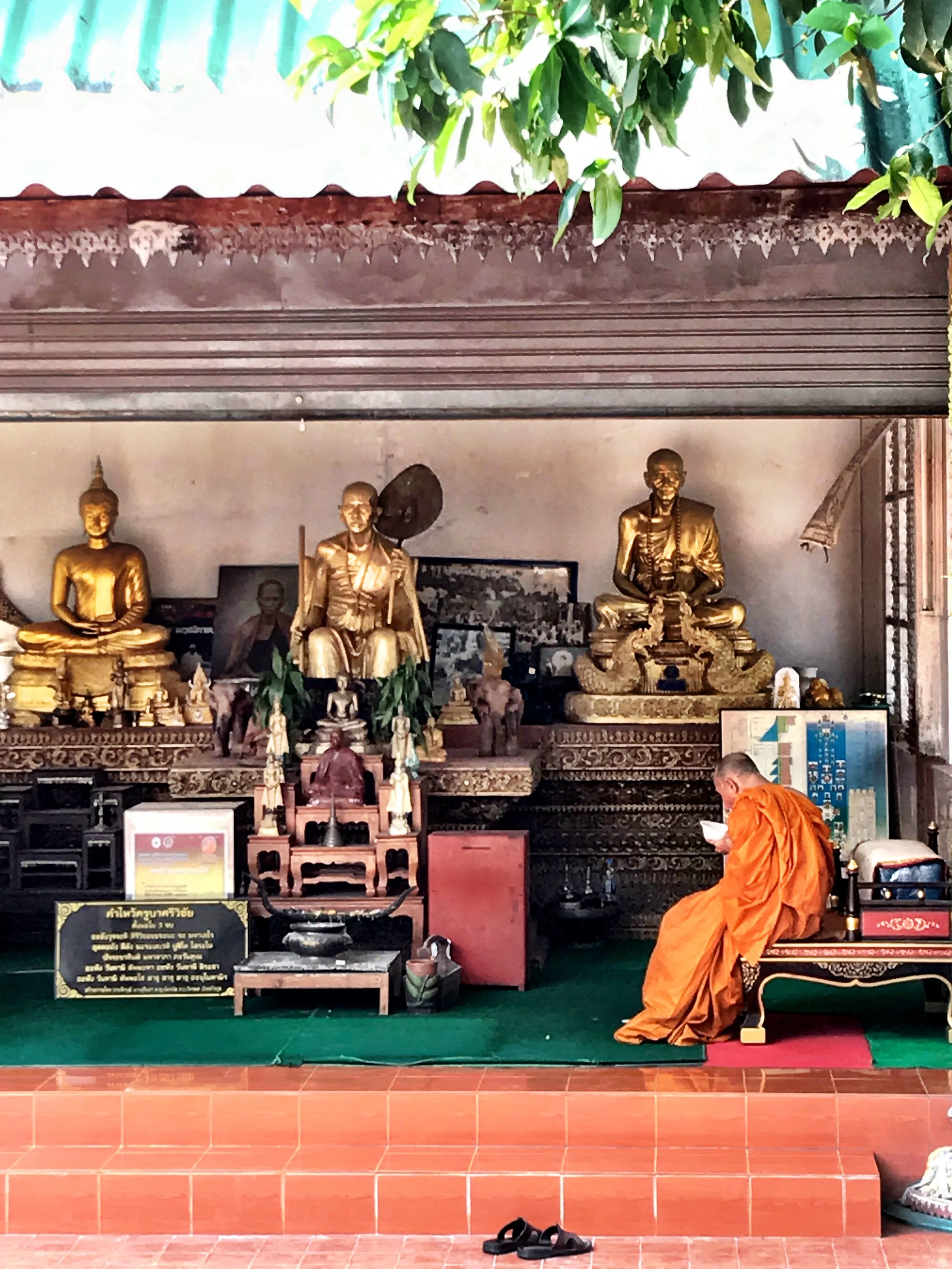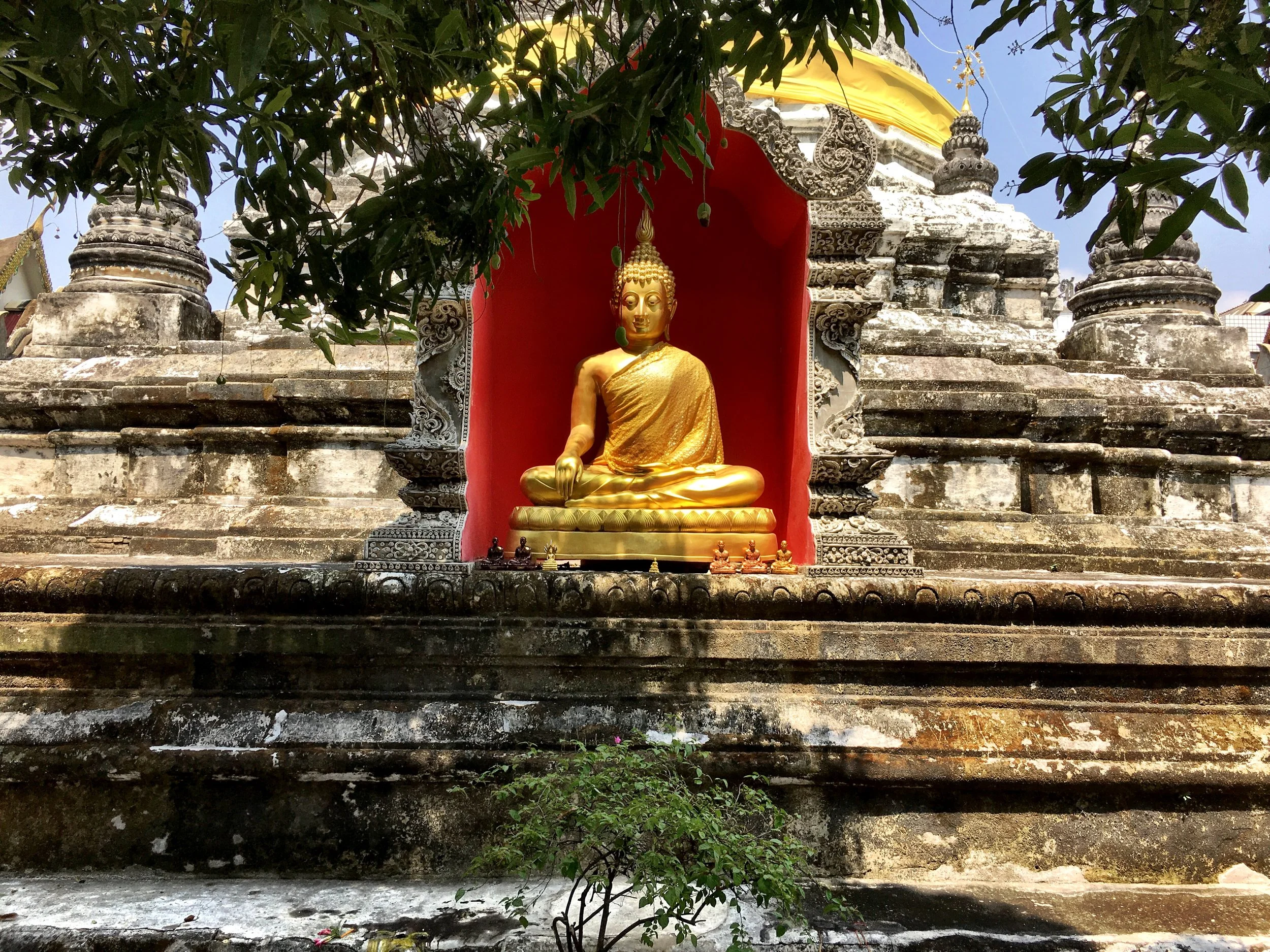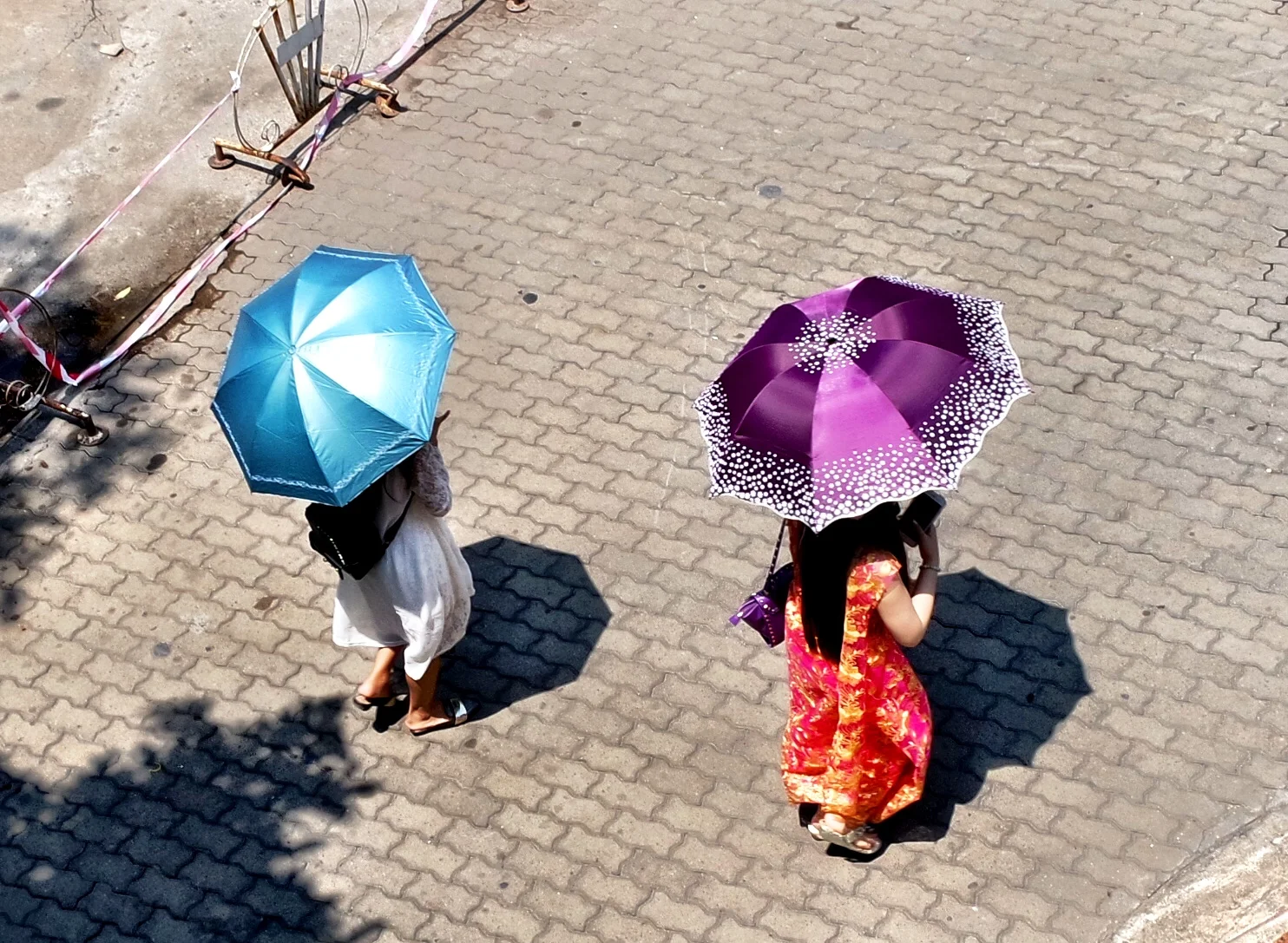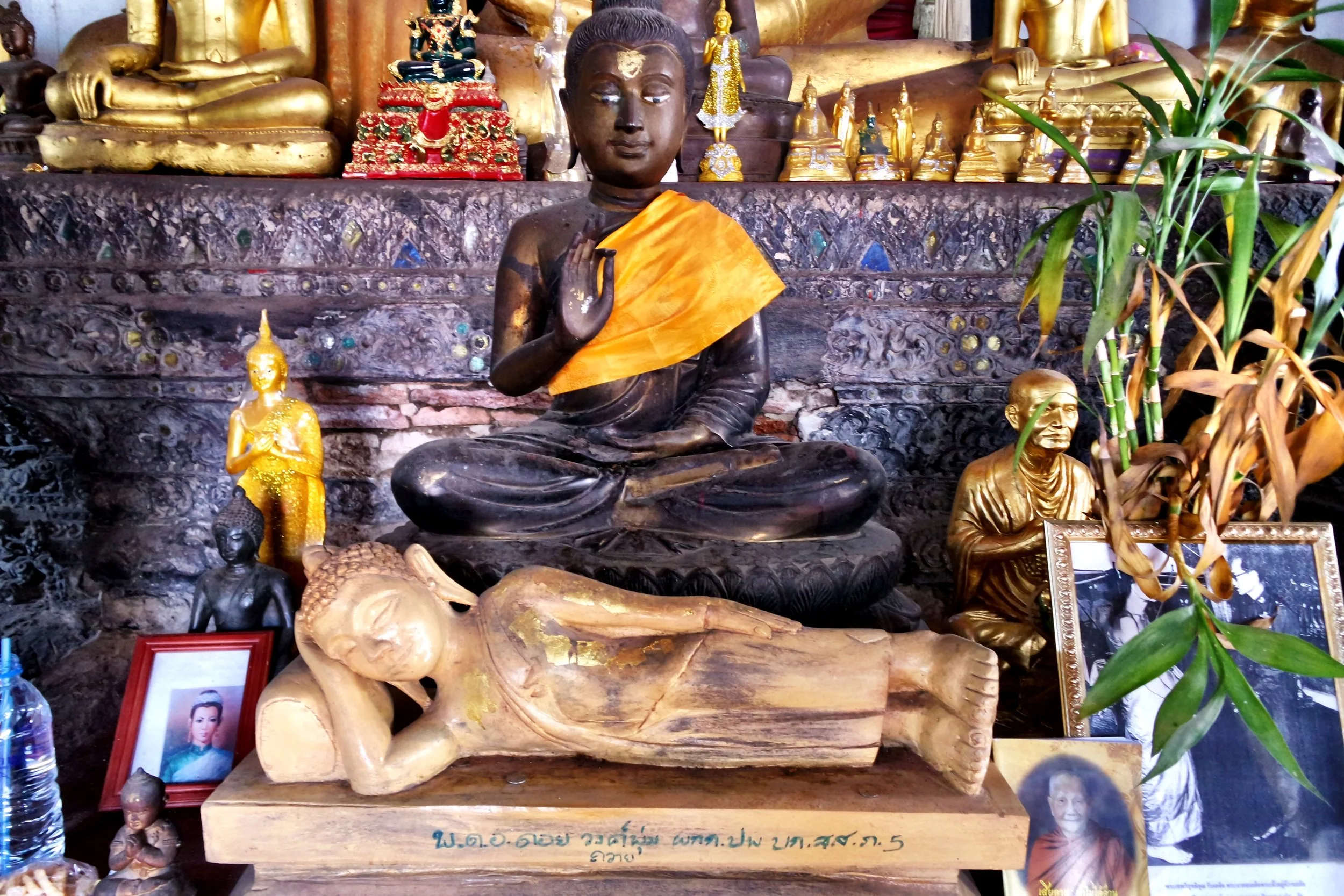One of our favorite Chiang Mai temples, this complex feels a bit like a Disney theme park.
The gorgeous Dhamma Hall exterior is a highlight of Wat Bupphram in Chiang Mai, Thailand. Can you spot Donald Duck eating a bowl of noodles out front?
Chances are that wherever you happen to be in Chiang Mai, you’ll find a temple nearby. It’s like Chicago and bars. The city is a melding of cultures, where the architectural influences of Thailand’s neighbors can be seen in its many religious buildings.
Dharma wheels decorate the exterior wall of the temple complex
An example of this integration can be seen in the Buddhist temple of Wat Buppharam, situated a short distance from the Old City. Once you cross the Narawat Bridge, there’s a quick succession of temples, and if you were to simply cast a fleeting glance at this simple whitewashed outer wall topped with dharmachakra wheels that face the busy street, you'd be missing out on a very special place. You’d also be missing out on a depiction of a Disney character wearing a familiar sailor shirt, cap, and a bowtie.
“The temple has appropriated the Disney cartoon character Donald Duck, standing and eating a bowl of noodles in the garden.”
Duke and Wally on the steps of the Dhamma Hall at Wat Bupphrama, resplendent in deep red with elaborate gold details
An Earth-Shaking History
Once you enter through the gate on southern side of Tha Phae Road, you’ll soon discover a temple that has developed a character all its own. A reminder of King Muangkaeo’s legacy, Wat Buppharam was constructed shortly after his ordination in 1495 on the site formerly occupied by the palace of his great grandfather King Tilokarat. Royal courts sponsored artists and erected temples as an act of religious merit making (a way to gain points toward enlightenment).
In 1497, Muangkaeo dedicated the monastery to the Lord Buddha, and according to historic documents, an intense earthquake occurred at the time of donation, but the temple withstood, undamaged. Seeing this as an auspicious sign — according to legend, an earthquake occurred prior to the Buddha’s death — the king had a silver Buddha image cast and placed within the temple chapel.
Duke says this Buddha is telling you, “Talk to the hand”
Talk to the Hand
The first building you’ll likely encounter is the large two-story Ho Phra Monthiantham, or Dhamma Hall, a communal center for Buddhist teaching and meditation. In front of the hall is a Buddha statue standing beneath a golden parasol with his right hand, palm out, raised to shoulder height. My first thought was of the dismissive ’90s phrase “talk to the hand,” which isn't completely off the mark. The posture is known as the pang ham yati, or pacifying the relatives position.
More surprising however is the appropriation of the Disney cartoon character Donald Duck, standing and eating a bowl full of noodles in the library hall garden. Like Ta Phrom in Angkor, Cambodia taking on the moniker of the Tomb Raider Temple after the Lara Croft film shot there, Wat Buppharam is referred to by some locals as the Donald Duck Temple. Wally and I found that many of the temple grounds in Chiang Mai have an element of whimsy to them, most notably in the form of statuary.
These sluglike creatures are called moms. You know how moms are: They’re never satisfied
Viharn 1
We decided to visit the small viharn, or prayer hall, located to the east of the Ho Monthiantham, first. It’s an elaborate affair of dark teak wood, stucco and ornate inlaid glass tiles with a low-slung, double-tiered roof. At its entrance you are welcomed by the curious mythological creatures hilariously called moms, one in silver and one in gold. A message beneath the gold one reads, “Please take off your shoes.” These aquatic creatures are from the Himavanta, a legendary forest that surrounds the base of Mount Meru, the home of the gods in Hindu mythology. Looking like a blunt-faced, late-stage-development tadpole-ferret hybrid, they serve as a reminder against clinging to impermanence and materiality. Moms are unable to satisfy their cravings — they endlessly gorge themselves, and because of this, they lack the necessary self-awareness to achieve enlightenment.
The viharn was originally erected in 1819 by Prince Thamalangka, who restored and renovated many of Chiang Mai’s temples after the Burmese had abandoned the city during the long skirmish between the two kingdoms.
Duke in the archway that leads to the chedi courtyard
The principal Buddha image was cast around 500 years ago and is seated in the Bhumisparsha mudra, or earth witness position, a gesture that represents the moment of enlightenment. Just before the Buddha reached nirvana, the demon king Mara tried to frighten him with armies of demons and monsters, including his daughters who tried to tempt Buddha to get out of meditation beneath the bodhi tree. When the Buddha’s hand touched the earth, it bellowed, “I bear you witness!” which in turn caused Mara and his minions to disappear.
Cats aren’t that common in Chiang Mai, but we found one resting in the second viharn, or prayer hall
Viharn 2
This prayer hall, found behind the other, has a large triangular pediment featuring a detailed carved wooden relief with a floral motif. The sacred structure is believed to be over 200 years old and contains a brass Buddha image cast around 500 years ago. It contains murals depicting scenes from one of the Jataka tales about the previous lives of the Buddha. This story, called the Vessantara Jataka tells of Prince Vessantara, who gives away everything he owns, demonstrating charity, one of the virtues of a bodhisattva.
A detail from the elaborately carved viharn doors
The richly carved front door panels of the Himavanta forest were replaced in 1983. We didn’t spot any moms, but a pair of hamsas, Buddhist geese, a symbol of purity and enlightenment, can be seen in the ornamental gable niche above the entrance.
A half-lion, half-dragon creature from Burmese mythology known as a chinthe helps protect the pagoda
Chedi
As Wally and I exited the second viharn and made our way to the chedi behind it, we passed a sign calling out a makeshift museum. Below the sign, a family of chickens happily strutted around, occasionally pecking at the dirt beneath.
This Buddha in a red niche is one of four at the base of the tower that is said to hold a sacred relic
The original chedi, or reliquary tower, was believed to have contained a sacred remnant of the Buddha. Its present form is a bulbous Burmese bell shape decorated with a combination of gold leaf and glass mosaic. The chedi was restored in 1958 and has a tiered square base supporting three rings of diminishing volume. Each side features a bright red alcove containing a golden Buddha, while the spire at the top is crowned by a hti, a finial ornament symbolic of a sacred umbrella.
A hen sits on her eggs in a pot by the chedi
We sat on a bench in the shade of one of the temple trees for a moment to take in the monument and while doing so, we heard a rustling in a nearby potted plant. Looking over, we saw a speckled black hen sitting atop the eggs she had laid in there.
Wally has a special affinity for these snakelike creatures called nagas
Dhamma Hall
Wally and I then proceeded to the largest and most recent structure within the complex. The two-story Ho Phra Monthiantham was erected by Abbot Phra Udom Kitti Mongkun and replaced the original wooden building that occupied the site in time for the 50th anniversary of King Bhumibol Adulyadej’s reign. Its entrance is guarded and flanked by makaras, creatures from Hindu mythology that possess the body of a dolphin combined with a crocodile.
The mondop style structure was influenced by the mandapa temples of Northern India and is characterized by a cruciform-shaped building, multi-tiered roof with upturned flame-like naga finials and a wraparound porch on the upper floor, topped with a spire.
Buddhist temples are filled with various statues in all sorts of mismatched styles
We took the staircase to the second floor, which contains the largest solid teak Buddha image in Chiang Mai. Painted in white and pale yellow, it was carved after a vision by King Sanphet II in the late 16th century, when he defeated the Burmese forces near Ban Muang Ngai, Thailand. This vision is depicted in the carved wood panels on the east wall. It’s believed to be 400 years old, and like the small viharn Buddha, is seated in the Bhumisparsha mudra, with additional smaller cast metal Buddha images in this position as well.
This playful mural by the artist Pornchai Jaima shows people worshipping a sacred tree
Expressive contemporary hand-painted murals by Thai artist Pornchai Jaima cover the walls of the lower level and possess a vivid, dreamlike depiction of traditional village life rendered in richly saturated hues.
Wally at Wat Bupphram, one of his favorite temples in Chiang Mai
Wat Buppharam features a combination of traditional elements and a dash of humor, which ended up making it onto Wally’s shortlist of favorites. Part of that had to do with Donald Duck I’m sure.
Wat Buppharam
Tha Phae Road
Tambon Chang Moi
Amphoe Mueang Chiang Mai
Chang Wat
Chiang Mai 50300, Thailand
